

By Steven Jay Griffel
Queens, NY, USA
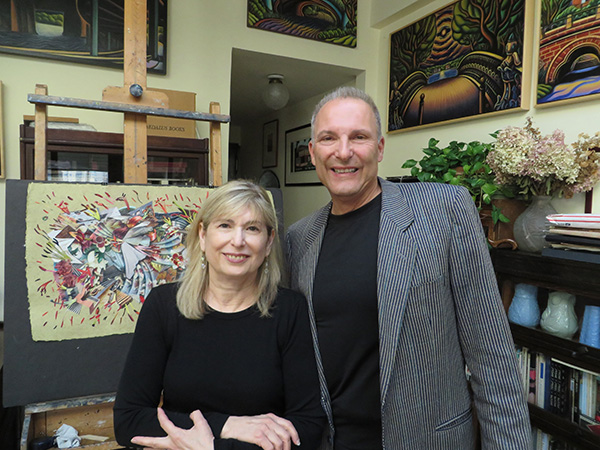
Bascove and Steven Jay Griffel
Don't judge a book by its cover – from The Mill on the Floss by George Eliot
Whenever I come across this famous aphorism I think of the artist known simply as Bascove. I first noticed Bascove's work around thirty years ago: along with Fred Marcellino, she was perhaps the preeminent American designer of book covers. The first cover art of hers I noticed was done for the novel Waiting for the Barbarians by J. M. Coetzee (who, many years later, would win the Nobel Prize for Literature).
I remember being riveted by the cover illustration: a standing brown person's legs; the fractured, disembodied feet being washed by a kneeling white man. These simple forms, expressed in modest colors and outlined in bold black lines, seemed to promise a layered narrative of social and symbolic importance. I couldn't wait to read the story. Now that's an effective book cover.
Throughout the '80s and '90s I read a thousand novels. Though I can think of a hundred I loved, I can name only a dozen or so favorite authors, among them: Robertson Davies, Jerome Charyn, and T. C. Boyle. That Bascove designed the covers of so many of the books I was drawn to read seemed to me a far-fetched coincidence. Even more surprising is that I happened to meet both Bascove and Fred Marcellino during those same years. Cynics might point out that we had mutual friends, or that we were all involved in the relatively small world of New York City publishing. I prefer to think it was Fate.
After meeting Bascove, I kept an eye on her career and soon learned that she should not be judged solely by her book covers. She is, in fact, an impressive and original artist: a startling painter, and a creator of suggestive collage.
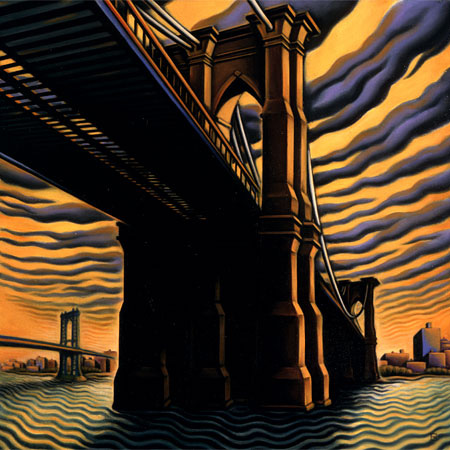
Brooklyn Bridge III, 2001
(courtesy of Bascove)
Bascove and I reconnected at a recent book party to celebrate Jerome Charyn's new novel I Am Abraham. When I learned that she would have a major new show in September, I asked to interview her for Stay Thirsty Magazine.
We met at her Manhattan home. The main room off the kitchen is her sunny studio. Two large wooden easels held works in progress, both collages. On the surrounding walls, and throughout the apartment, are framed collages and paintings. I was reminded that bridges and books are Bascove's predominant themes.
STEVEN JAY GRIFFEL: It's wonderful to see some of your most famous bridge paintings in person. How did you become interested in bridges?
BASCOVE: In the late 70s I lived in Paris, near the Seine. A fairly active neighborhood, but early Sunday mornings the streets were quiet and blissfully deserted, the perfect time to take my dog on walks along the river. I started taking my watercolors too. Those first bridge watercolors were more like sketches, loose washes in variations of stone colors and pastels. You can't help but think of the bridges' histories: witnesses to untold generations of strolling lovers; hundreds of years of turbulent political change. Moving back to Manhattan, I again lived near a river, not unusual on this narrow island, and would walk my dog under the Queensboro Bridge. I've painted, photographed, carved, and collaged the Queensboro. It's the bridge I know best.
STEVEN JAY GRIFFEL: I've read that there are more than 2,000 bridges in New York City. Many of them are quite large and famous, most relatively small and modest. What makes you want to paint a particular one?
BASCOVE: I've had a wise and powerful muse in the person of the magnificent artist, John Baeder. Privileged to go with him on some of his early scouting for his beloved diners, I saw how he would plan his photographs to catch the light of certain hours of the day, how he loved talking to the owners and employees. He adored everything about diners and roadside eateries. It was his art, his passion, and field of study.
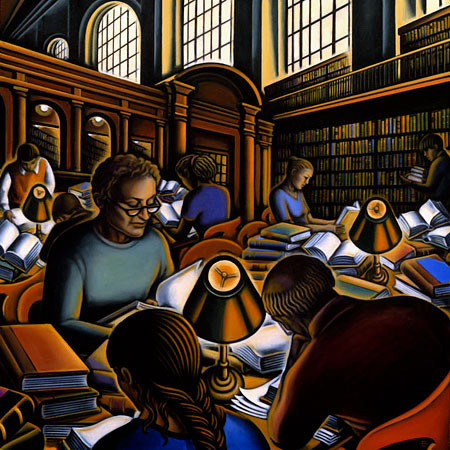
Library, 2000
(courtesy of Bascove)
When I first began to paint bridges, I chose the ones I saw most often, the ones that were part of my life. First the Queensboro, and then the three Harlem River Bridges that my husband (architect Michael Avramides) and I would pass on our way to the Bronx, where he's designed and built numerous buildings. My exhibition at the Museum of the City of New York was scheduled at the time of the Centennial festivities, which celebrated the consolidation of the five boroughs into New York City. It was the major bridges, crossing the Hudson and East Rivers that made it possible. They interconnected the communities, culture and commerce of the city. Those bridge paintings were essential to include in the show.
Other choices are more serendipitous. The Macombs Dam Bridge was near Michael's favorite mozzarella place, so, of course, that needed to be explored. A dear friend gave me a ticket to a lecture to hear Margot Ammann Durrer speak about her father, Othmar Ammann, who had designed many of the city's most famous bridges, including the George Washington Bridge and the Verrazano-Narrows Bridge. I introduced myself to her. She knew my paintings of her father's work and, immediately, we were kindred souls. She introduced me to several members of the audience from the Central Park Conservancy, who asked, "Why haven't you painted our bridges?" That began the Central Park project.
STEVEN JAY GRIFFEL: You have made a point to learn about the history of the bridges you paint.
BASCOVE: Fortunately, I've met several people who are deeply knowledgeable about the romance and history of New York City. The marvelous Barbara Ball Buff, at the Museum of the City of New York, gave me access to the museum's bountiful library and would regale me with some of the City's more eccentric lore. Did you know that one of the Queensboro Bridge's towers housed an artist's studio in the 1920s? It was discovered when The New York Times reported an unusual robbery there; a thief had climbed up the tower and stole several canvases.
Later, reading the masthead of the newsletter of the Transit Museum, I discovered someone else who was besotted with transport. Meeting Laura Rosen, then the MTA's Robert Moses Archivist for Bridges and Tunnels, was life changing. Amazingly, it turned out that we had attended the same college, a year apart (though brilliant Laura was off to Harvard after graduation). A master photographer, there are two gorgeous books of her work on New York City, The Top of the City, forward by Brendan Gill, and Manhattan Shores. We are dear friends, and my research would be woefully inept without her. She has given fascinating talks at several of my exhibitions. Next spring this wise woman will bring her great charm and encyclopedic knowledge to a talk at The Noble Maritime Collection.
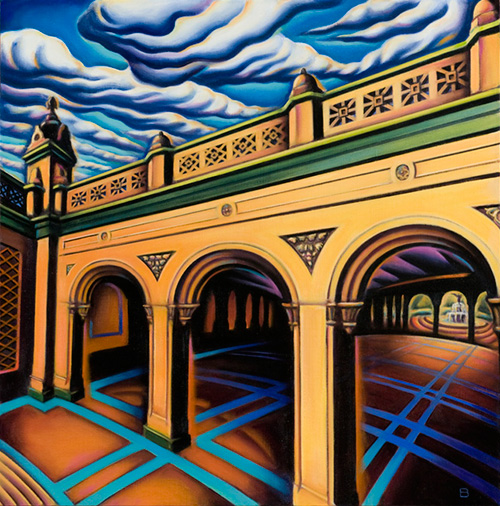
Terrace Bridge, 2009
(courtesy of Bascove)
STEVEN JAY GRIFFEL: Do you usually paint a bridge from real life? Some have very long central spans. How do you decide which perspective to show?
BASCOVE: The bridges are painted from photographs. I try to see each bridge from as many angles as possible, moving all around it, walking across it if there's a foot or bicycle path. Michael will drive me over and back and around it. Sometimes the tolls do add up! There will often be several visits, at different times of day and with different light. The paintings are composites of several photographs from various views. The collages are actually a step closer to the original shooting sessions: they are made of dozens of photographs, spliced and joined in spontaneous arrangements. They move and go where they want to go; there is no attempt to show the bridge structure in a readily recognizable form.
STEVEN JAY GRIFFEL: The word "bridge" is often used symbolically. What deeper meaning does "bridge" have for you? How do your deep feelings about bridges relate to your feelings about books and reading?
BASCOVE: Both books and bridges are ways of spanning distances and being connected. There is also that sense of being suspended in a place that has an existence separate from either side.
STEVEN JAY GRIFFEL: Your style and color palette seem pretty consistent, whether you are painting bridges or book reading. However, your book-reading paintings often include human figures and seem much more personal. What is your take on the figurative elements in your paintings?
BASCOVE: Something mysterious happens to us when we read, it feels like a state as intimate as dreaming. Our bodies are still, almost forgotten, our minds are riveted, enthralled, focused on innumerable places, times, and situations. I began as a figurative painter. There is a rich history of the art of people reading, so it seemed natural to explore that state of absorption. My friends kindly posed for me, their children patiently put up with me. Libraries have also been a significant part of my life and ours in Manhattan is a veritable treasure. It was a wonderful gift to get permission to photograph the New York Public Library's grand Reading Room before hours, and a great pleasure that the preliminary drawing for that painting is part of their collection.

Bronx Whitestone Bridge, 1998
(courtesy of Bascove)
STEVEN JAY GRIFFEL: Knowing you as I now do, it seems eminently fitting that you would have become a designer of book covers. How did that come about?
BASCOVE: I'm a constant reader. While in college I admired the book-cover art gracing my copies of AndréGide and Willa Cather, and also the record jackets of readings by Dylan Thomas. I had also seen Antonio Frasconi's refreshingly beautiful woodcut illustrations. Like the work of Ben Shahn, they had a distinct line quality that lent itself to social and philosophical commentary. I knew that's what I wanted to do.
At that time, book jacket assignments were given to men. Women illustrators could find a place in fashion, children's books, cookbooks, and women's magazines. Except for fashion, I did my share of such work and met a lot of terrific people along the way.
It was as a result of my publishing experience with children's educational material and high-school literature that I was assigned my first cover for a literary classic: an abridged version of The Brothers Karamazov. Around this time, John Baeder introduced me to Steve Heller, who worked at The New York Times. Steve started giving me assignments for the New York Times Book Review, an excellent discipline for direct, uncluttered thinking. With those pieces, and after many run-arounds, I finally got an appointment at Harcourt, Brace, Jovanovich. I left with a job. HBJ provided me with a wealth of books by thought-provoking authors, Amos Oz, Virginia Woolf, Georges Simenon, Italo Calvino, and Alice Walker among them. Many of those covers won awards and other publishing houses started to call.
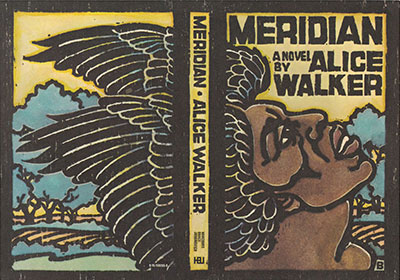
Alice Walker, Meridian, 1976
(courtesy of Bascove)
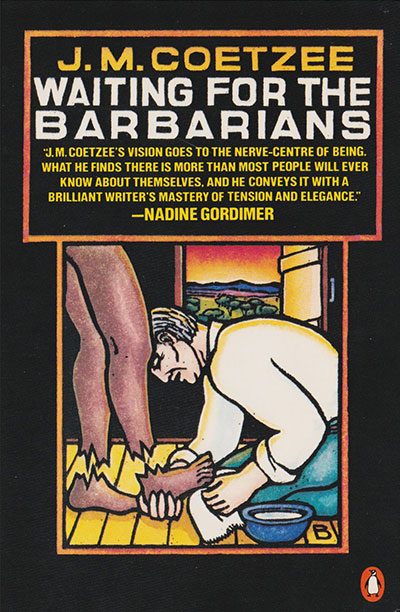
Waiting for the Barbarians, 1982
(courtesy of Bascove)
STEVEN JAY GRIFFEL: You have worked directly with some authors when developing cover art for their books. How did these relationships influence your artistic expression?
BASCOVE: I always felt that my job was to be true to what the writer was saying, to express the author's words in an image that the reader would understand. If I had already illustrated other books by the same author, the experience certainly became much richer.
Robertson Davies and I had some parallel appreciations. Years earlier we had both been involved with the Jung Institute in New York City. He was giving lectures while I was studying Jungian imagery. Towards the end of our many years of working together, we found out, by chance, that we each kept a reproduction of Arcimboldo's "The Librarian" over our desks.
With Jerome Charyn it was an exquisite moment when he and Michael met and shared their love and knowledge, street by street, of the Bronx. We've had many meals and made many road trips there together.
STEVEN JAY GRIFFEL: You mentioned that outside factors such as politics and norms of political correctness sometimes impacted your artistic freedom as a book cover designer. Can you give me an example?
BASCOVE: There is, obviously, continued racism in our society. It was more open in the 1970s through the 80s when I was working as an illustrator. Most of my editorial work was for The New York Times and The Progressive, where the subject of racism never impacted my work. However, publishing houses had different ways of dealing with it. At one house I was given the work of Alice Walker to illustrate and there were no restrictions. At another house, I was not permitted to show black Africans on covers by J. M. Coetzee after, as I was told, Waiting for the Barbarians was kept off the shelves in bookstores in the South. I felt it was disloyal to Coetzee's political views, but his editors and others insisted it was more important to get his books into bookstores than to be overly concerned about book jacket imagery. This also happened with my cover for Andre Brink's The Wall of the Plague. There, I just made the captivating, romantic interest the color blue – that seemed to pass.
STEVEN JAY GRIFFEL: You have published three books that combine your passion and talents for painting and reading. What have those experiences been like?
BASCOVE: STONE and STEEL originally started as a catalog for my exhibit at the Museum of the City of New York. When my research began, I realized that information about dates and construction were of less interest to me than a more deeply-felt approach. The words of Gay Talese, Helen Keller, and Louis Mumford more truly articulated my passion about bridges, and that's what I wanted to share.

STONE and STEEL, 1998
(courtesy of Bascove)
It must be said that these books were done with David R. Godine, a serious bibliophile with a well-deserved reputation for producing beautiful books. I had done numerous paintings on these subjects and was given full reign to choose the accompanying texts and to design the covers. It was a joy. How could it not be, searching and reading intently for stories, poems, anything that could relate to my obsessions of bridges, reading, and food? I searched for selections from various cultures and wanted half the voices to be those of women. It was like a treasure hunt. It was great fun finding a poem about the Manhattan Bridge that had been originally written in Yiddish, or one about writing poetry translated from Chinese. Friends provided suggestions and introductions. Most of the publishing houses I had previously been involved with generously accepted my exceedingly small budget for reprint rights. There were poems and essays from several of the authors I had worked with and knew personally. The title for the reading book, Where Books Fall Open, came from a favorite (included) poem by the extraordinary poet James Seay. We met after I did a cover for his book, The Light as They Found It.
STEVEN JAY GRIFFEL: Looking at your two easels, it seems you are currently focused on creating collage. How does this art compare with your painting?
BASCOVE: Recently I've been mulling over the primal idea that has always driven artists – how to make order out of chaos – and how relevant is that thin boundary between order and chaos. Exploring more abstract forms also means constantly questioning balance and perspective. With enormous pleasure, I've been exploring many of the passions that were only touched on in my previous work – astronomy, engineering, architecture, history, and natural science. Collage has been liberating and great fun for this pursuit.
STEVEN JAY GRIFFEL: I see some strong thematic connections between your paintings and collages.
BASCOVE: Spirals were always part of the underlying structure of my paintings. Many compositions were based on the Golden Section and the system of Fibonacci numbers. Now, working on collages, I play with photographs of spiral shells, ammonites, and staircases and merge them with overhead views of hurricanes and spiral galaxies. The moon is another favorite subject of mine. Moons are often in the skies above my bridge paintings. I just spent several months making a collage, drawing inspiration from a long-loved poem called Moon by Mark Strand. It's probably no surprise that, even in these pieces, books and bridges continue to be essential elements.
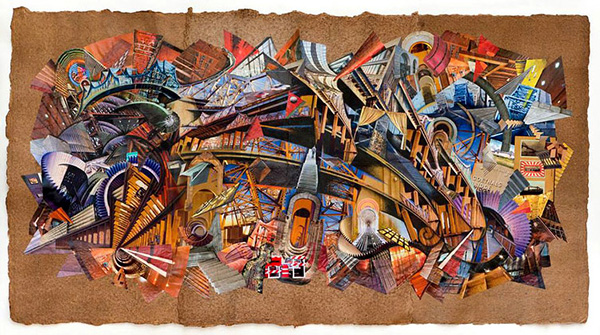
Goethals Bridge (Requiem), 2014
(courtesy of Bascove)
STEVEN JAY GRIFFEL: I'm looking forward to seeing your new exhibit that opens on September 20th at Staten Island's Snug Harbor Cultural Center. What will you be showing? Any new pieces?
BASCOVE: I'll be showing at The Noble Maritime Collection, one of the jewels of the Snug Harbor Cultural Center. Staten Island is home to New York City's most historical infrastructure. This is a timely exhibition. Several bridges in Staten Island are undergoing major renovations to conform to both modern shipping standards and the growing environmental concerns of the community. The roadbed of the Bayonne Bridge is being raised. Doubtlessly it will look less elegant, but it's better than destroying the bridge, as first plans suggested. The Goethals Bridge is being completely rebuilt. The replacement will have walking and bike lanes and traffic and weather sensors incorporated into its structure. This November celebrates the 50th Anniversary of the Verrazano-Narrows Bridge, a crucial connection to New York Harbor and to local and regional highway systems.
My new pieces will be of the current Goethals (a requiem) and the Outerbridge Crossing. They are both done in collage and there will be other bridge collages that have never been shown before. Many of the exhibited paintings will be on loan from various gracious collectors, so this may be the last time they are together.
EXHIBITION
Bascove/Bridges Transcending the Metropolis
September 20th 2014 - June 21st 2015
Snug Harbor Cultural Center
The Noble Maritime Collection
1000 Richmond Terrace, Staten Island, NY
Links:
Steven Jay Griffel's Profile at Stay Thirsty Publishing
Steven Jay Griffel on Facebook







